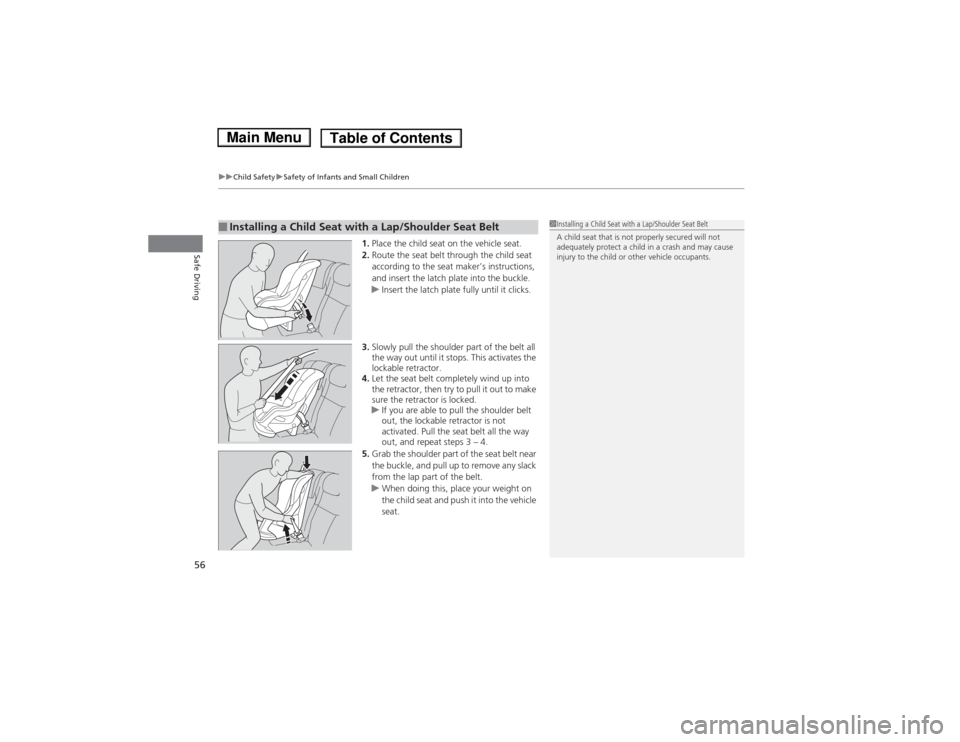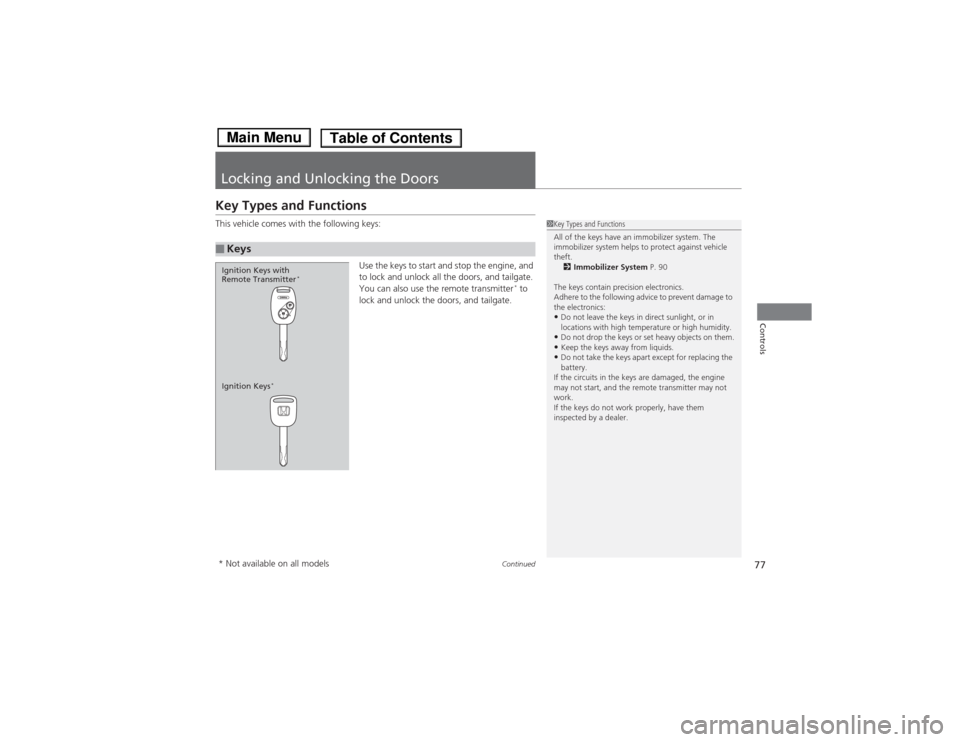Page 56 of 289
Continued
55
uuChild SafetyuSafety of Infants and Small Children
Safe Driving
3.Put the head restraint to its upright, then
route the tether strap between the head
restraint legs, and secure the tether strap
hook onto the anchor.
4.Tighten the tether strap as instructed by the
child seat maker.
5.Make sure the child seat is firmly secured by
rocking it forward and back and side to
side; little movement should be felt.
6.Make sure any unused seat belt that a child
can reach is buckled, the lockable retractor
is activated, and the belt is fully retracted
and locked.
Flexible Type
1Installing a LATCH-Compatible Child Seat
For your child’s safety, when using a child seat
installed using the LATCH system, make sure that the
seat is properly secured to the vehicle. A child seat
that is not properly secured will not adequately
protect a child in a crash and may cause injury to the
child or other vehicle occupants.
Anchor
Tether Strap Hook
Page 57 of 289

uuChild SafetyuSafety of Infants and Small Children
56Safe Driving
1.Place the child seat on the vehicle seat.
2.Route the seat belt through the child seat
according to the seat maker’s instructions,
and insert the latch plate into the buckle.
uInsert the latch plate fully until it clicks.
3.Slowly pull the shoulder part of the belt all
the way out until it stops. This activates the
lockable retractor.
4.Let the seat belt completely wind up into
the retractor, then try to pull it out to make
sure the retractor is locked.
uIf you are able to pull the shoulder belt
out, the lockable retractor is not
activated. Pull the seat belt all the way
out, and repeat steps 3 – 4.
5.Grab the shoulder part of the seat belt near
the buckle, and pull up to remove any slack
from the lap part of the belt.
uWhen doing this, place your weight on
the child seat and push it into the vehicle
seat.
■Installing a Child Seat with a Lap/Shoulder Seat Belt
1Installing a Child Seat with a Lap/Shoulder Seat Belt
A child seat that is not properly secured will not
adequately protect a child in a crash and may cause
injury to the child or other vehicle occupants.
Page 58 of 289
Continued
57
uuChild SafetyuSafety of Infants and Small Children
Safe Driving
6.Make sure the child seat is firmly secured by
rocking it forward and back and side to
side; little movement should be felt.
7.Make sure any unused seat belt that a child
can reach is buckled, the lockable retractor
is activated, and the belt is fully retracted
and locked.
Two tether anchorage points are provided
behind the rear outer seating positions and
one in the ceiling for the rear center. A child
seat that is installed with a seat belt and
comes with a tether can use the tether for
additional security.
1Installing a Child Seat with a Lap/Shoulder Seat Belt
To deactivate a lockable retractor, release the buckle
and allow the seat belt to wind up all the way.
■Adding Security with a Tether
1Adding Security with a Tether
Since a tether can provide additional security to the
lap/shoulder seat belt installation, we recommend
using a tether whenever one is available.
Tether Anchorage Points
Page 68 of 289

67
uuIndicatorsu
Continued
Instrument Panel
Indicator
Name
On/Blinking
Explanation
ABS (Anti-lock
Brake System)
Indicator
●Comes on for a few seconds when you
turn the ignition switch to ON
(w, then
goes off.
●If it comes on at any other time, there is
a problem with the ABS.
●Stays on constantly - Have the vehicle checked by
a dealer. With this indicator on, your vehicle still has
normal braking ability but no anti-lock function.
2ABS (Anti-lock Brake System) P. 183
Supplemental
Restraint System
Indicator
●Comes on for a few seconds when you
turn the ignition switch to ON
(w, then
goes off.
●Comes on if a problem with any of the
following is detected:
-Supplemental restraint system
-Side airbag system
-Side curtain airbag system
-Seat belt tensioner
●Stays on constantly or does not come on at all
- Have the vehicle checked by a dealer.
High Temperature
Indicator
●Comes on for a few seconds when you
turn the ignition switch to ON
(w, then
goes off.
●Blinks when the engine coolant
temperature goes up, and stays on if the
temperature continues to rise.
●Blinks while driving - Drive slowly to prevent
overheating.●Stays on while driving - Immediately stop in a
safe place and allow the engine to cool.
2Overheating P. 254
Low Temperature
Indicator
●Comes on for a few seconds when you
turn the ignition switch to ON
(w.
●Comes on when the engine coolant
temperature is low.
●If the indicator stays on after the engine has reached
normal operating temperature, there may be a
problem with the temperature sensors. Have the
vehicle inspected by a dealer.
Page 71 of 289

70
uuIndicatorsu
Instrument Panel
Indicator
Name
On/Blinking
Explanation
Turn Signal
Indicators
●The turn signal indicators blink when you
operate the turn signal lever.●If you press the hazard warning button,
both indicators and all turn signals blink
at the same time.
●Does not blink or blinks rapidly - A turn signal
light bulb has blown. Change the bulb immediately.
2Replacing Light Bulbs P. 213, 216
High Beam Indicator
●Comes on when the high beam
headlights are on.●Comes on with reduced brightness when
DRL (daytime running lights) are on.
—
Lights On Indicator
●Comes on whenever the light switch is
on when the exterior lights are on.
●If you remove the key from the ignition switch while
the lights are on, a chime sounds when the driver’s
door is opened.
Fog Light Indicator
*
●Comes on when the fog lights are on.
—
Immobilizer System
Indicator
●Comes on briefly when you turn the
ignition switch to ON
(w, then goes off.
●Comes on if the immobilizer system
cannot recognize the key information.
●Blinks - You cannot start the engine. Turn the
ignition switch to LOCK
(0, pull the key out, and
then insert the key and turn it to ON
(w again.
●Repeatedly blinks - The system may be
malfunctioning. Have the vehicle checked by a
dealer.●Do not attempt to alter this system or add other
devices to it. Electrical problems can occur.
* Not available on all models
Page 76 of 289

75
Controls
This chapter explains how to operate the various controls necessary for driving.
Setting the Clock................................ 76
Locking and Unlocking the Doors
Key Types and Functions .................... 77
Locking/Unlocking the Doors from the
Outside ............................................ 79
Locking/Unlocking the Doors from the
Inside ............................................... 82
Childproof Door Locks ....................... 83
Auto Door Locking/Unlocking
*.......... 84
Opening and Closing the Tailgate
Using the Key
*................................... 88
Using the Tailgate Open Handle ......... 89
Security System.................................. 90
Immobilizer System ............................ 90Security System Alarm
*...................... 90
Opening and Closing the Windows.. 92
Operating the Switches Around the
Steering Wheel
Ignition Switch ................................... 94
Turn Signals ....................................... 95
Light Switches.................................... 95
Fog Lights
*........................................ 96
Daytime Running Lights ..................... 96
Wipers and Washers .......................... 97
Brightness Control ............................. 99
Rear Defogger/Heated Door Mirror
*
Button ........................................... 100
Adjusting the Steering Wheel........... 101Adjusting the Mirrors....................... 102
Interior Rearview Mirror ................... 102
Power Door Mirrors ......................... 102
Adjusting the Seats.......................... 103
Adjusting the Seat Positions ............. 103
Interior Lights/Interior Convenience
Items................................................ 111
Interior Lights .................................. 111
Interior Convenience Items .............. 113
Heating and Cooling
*....................... 118
Using Vents, Heating and A/C
*........ 118
* Not available on all models
Page 77 of 289
76Controls
Setting the ClockClockYou can adjust the time in the clock display, using the CLOCK button with the
ignition switch in ACCESSORY
(q or ON
(w.
1.Press and hold the CLOCK button until the clock display begins to blink.
2.Press the
(1 (Hour) button to change the hours.
3.Press the (2 (Minute) button to change the minutes.
4.Press the CLOCK button to go back to the normal display.
■Adjusting the Time
1Clock
Press and hold the CLOCK button until the clock
display begins to blink, then press the
(3 (Reset)
button.
Depending on the displayed time, the clock sets
forward or backward.
Example:
1:06 will reset to 1:00
1:53 will reset to 2:00
The clock is automatically updated through the
navigation system, so the time does not need to be
adjusted.
Models without navigation system Models with navigation system
Models without navigation system(1 Button(3 ButtonClock Display
CLOCK Button(2 Button
Page 78 of 289

77
Continued
Controls
Locking and Unlocking the DoorsKey Types and FunctionsThis vehicle comes with the following keys:
Use the keys to start and stop the engine, and
to lock and unlock all the doors, and tailgate.
You can also use the remote transmitter
* to
lock and unlock the doors, and tailgate.
■Keys
1Key Types and Functions
All of the keys have an immobilizer system. The
immobilizer system helps to protect against vehicle
theft.
2Immobilizer System P. 90
The keys contain precision electronics.
Adhere to the following advice to prevent damage to
the electronics:•Do not leave the keys in direct sunlight, or in
locations with high temperature or high humidity.•Do not drop the keys or set heavy objects on them.•Keep the keys away from liquids.•Do not take the keys apart except for replacing the
battery.
If the circuits in the keys are damaged, the engine
may not start, and the remote transmitter may not
work.
If the keys do not work properly, have them
inspected by a dealer.
Ignition Keys
*
Ignition Keys with
Remote Transmitter
*
* Not available on all models